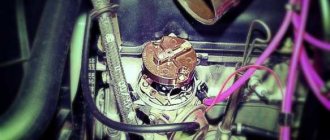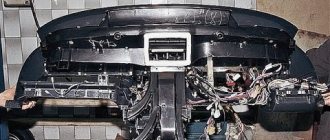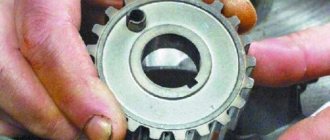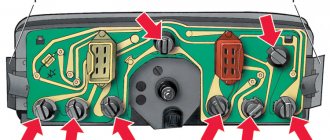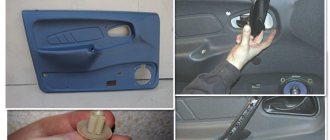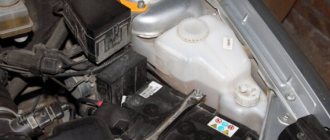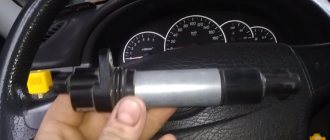What is a slider with a resistor and what role does it play in the ignition distributor?
A slider with a resistor is a rotor of the ignition distributor of a contact and non-contact ignition system, equipped with an interference suppression resistor.
Any ignition system is a powerful source of radio interference that disrupts the reception of radio programs in all ranges both in the car itself and in vehicles passing nearby. This noise is heard as clicks and crackles, the frequency of which increases with increasing engine speed. Interference is generated by sparks that occur in various parts of the high-voltage circuit of the ignition system: in the spark gaps of the spark plugs and between the contacts in the cover and the distributor slider. When a spark jumps, electromagnetic radiation of a wide spectrum occurs - this is why interference is heard on almost all radio bands. However, the spark itself produces radiation of low intensity; the main power is emitted by components associated with the spark gap - high-voltage wires that act as antennas.
To combat the described phenomenon, additional elements are introduced into the high-voltage circuit of the ignition system - distributed or concentrated resistances. High-voltage wires with non-metallic central cores act as distributed resistances. The resistors in the spark plugs and in the distributor slider act as concentrated resistances—it is this detail that will be discussed further.
Why does introducing a resistor into a high-voltage circuit reduce the noise level? The reason is quite simple. When a breakdown of the spark gap occurs, high-frequency currents run through the conductor connected to it, which leads to the emission of radio waves by this conductor. Placing a resistor with a resistance of several thousand ohms between the spark gap and the conductor changes the picture: together with the capacitances and inductances that conductors always have, a simple filter is formed that cuts off the high-frequency component of the interference. In practice, a complete cut does not occur, but the amplitude of high-frequency currents in the wire decreases sharply, which leads to a multiple decrease in the level of radio interference in the high-voltage circuit of the ignition system.
If we relate all of the above to the distributor runner, then the spark gap here is the contacts of the cover and the contact of the runner passing nearby, and the antennas are the high-voltage wires running from the coil to the runner and from the contacts to the spark plugs. Thus, here the resistor is between two conductors, however, the greatest suppression of interference occurs on the wire from the coil, and suppression of interference on the spark plug wires occurs due to the resistance of the wires themselves and the resistors built into the spark plugs.
That is why this resistor is called noise-suppressing (or simply suppressing). However, in addition to combating radio interference, the resistor also performs several more functions:
- Preventing (or reducing the intensity) burnout of the contacts of the distributor cover and the slider itself;
- Reducing the likelihood of electrical breakdown from other high-voltage sources;
- Increased service life of spark plugs and related components;
- Increasing the duration of the spark discharge, which in some cases increases the stability of the engine.
Why is all this happening? The reason is the resistance to electric current that the resistor creates. Due to the resistance in the high-voltage circuit, the current strength decreases during the discharge - it is enough for the spark between the electrodes of the spark plugs to ignite the combustible mixture, but not enough for the local melting of the metal of the electrodes and contacts in the distributor. In this case, the power stored in the coil remains the same, however, due to the increased resistance of the circuit, it is given to the spark plugs not instantly, but over a certain period of time - this leads to an increase in the discharge time, which ensures more reliable ignition of the mixture in the cylinders.
Thus, just one resistor in the ignition distributor slider performs several functions that increase engine efficiency and vehicle operating comfort.
BB wires
High-voltage wires (HV wires) of the ignition system are designed to transmit high-voltage pulses from the ignition coil to the spark plugs. Structurally, such a cable is a metal central conductor covered with a layer of insulation made of PVC, rubber or polyethylene, as well as a special layer that increases the resistance of the wire to chemical influences (fuel, oil). Today, silicone explosive wires, which are characterized by high elasticity at low temperatures, have become widespread. Such cables work great in wet weather and do not overheat.
Spark plug wires provide connection to the ignition coil, distributor and spark plugs
Malfunctions
The occurrence of problems with spark plug wires manifests itself in the form of unstable operation of the power unit:
- problematic engine starting, especially in wet weather;
- interruptions in the operation of the power plant at medium and high speeds;
- if the central conductor is damaged, the motor stalls;
- power decreases;
- fuel consumption increases.
Problems with high-voltage wires arise mainly due to aging. Over time, the insulating layer becomes covered with small cracks, which is caused by temperature changes in the engine compartment. As a result, a current leak appears through the damaged areas: a spark breaks through to ground and there is not enough electricity for normal sparking. When dirt accumulates on the surface of wires and protective caps, the surface conductivity of the insulation increases, which leads to current leakage. In addition, leakage is also possible due to oxidation of the cable contacts, when the tightness of the protective cap is broken, for example, if it is damaged.
One of the malfunctions of high-voltage wires is a break
How to check
Before proceeding with a more detailed diagnosis of explosive wires, you need to inspect them for damage, such as cracks, fractures, tears in protective caps, etc. After this, you can resort to one of the following methods:
- Use a known-good cable. To do this, we disconnect the explosive wires one by one, replacing them with a spare one. If stable operation of the motor resumes, this will indicate a damaged element.
- Wait until dark. When darkness comes, open the hood and start the engine. In the event of a cable breakdown, a spark will be clearly visible on the faulty element.
- Use an additional wire. To do this, we use an insulated piece of cable, stripping both ends. We connect one of them to ground, and run the second one along the spark plug wire, especially in the places of bends and caps. If a high-voltage cable breaks through, a spark will appear in the problem area between the additional wire.
- Diagnostics with a multimeter. Using the device, we determine the resistance of the cables by selecting the ohmmeter mode. Having disconnected the wires from the ignition coil and distributor, we measure the resistance one by one. A working wire should have a reading of about 5 kOhm. If the central core is broken, the values will be missing.
If any kind of malfunction is detected with the spark plug wires, it is necessary to replace them, and not only the problematic cable, but the entire set.
Video: diagnostics of high-voltage wires
Which ones to put
The choice of explosive wires is a responsible undertaking, since they directly affect the performance of the power plant, and a high price is not always an indicator of quality. It is best to give preference to spark plug wires with a copper central core. The resistance should be about 4 kOhm. Wires with zero resistance lead to rapid burnout of the central electrode of the spark plug and its premature failure. When choosing, you should pay attention to the following manufacturers:
- BERU;
- NGK;
- PARTS-MALL;
- AMD;
- Bremi;
- Tesla Technics.
Today a large selection of spark plug wires is offered, but it is better to give preference to well-known manufacturers
Design and characteristics of a slider with a resistor
The slider (rotor) with a resistor consists of several parts: a cast body, two rigidly fixed contacts (central, resting on a corner in the distributor cover, and a side one) and a cylindrical resistor located in a special recess. The housing is made of electrically insulating material; the contacts are usually fixed to it using rivets. The contacts have spring plates, between which a resistor is clamped. In the lower part of the slider body there is a shaped channel for fixation on the ignition distributor shaft.
According to the method of installing the resistor, there are two types of sliders:
- With replaceable resistor;
- With a non-replaceable resistor - the part is filled in a recess with a special insulating compound based on epoxy resin or glassy materials.
The runners use powerful resistors of a special design with end leads, designed for installation between spring contacts. In domestic cars, resistors with a resistance of 5.6 kOhm are most often used, but in various sliders you can find resistors with a resistance of 5 to 12 kOhm.
Depending on the type of distributor, the slider can be simply mounted on the distributor shaft (usually such parts are T-shaped), or mounted with two screws on the ignition timing regulator (such parts are made in the form of a flat cylinder). In both cases, the resistor is mounted on the outside of the slider, which allows access to its inspection and, if possible, replacement.
Which distributor is suitable for the VAZ-2107
On all carburetor rear-wheel drive VAZ cars, the device has almost identical components and a similar operating principle. Distributors for engines with a volume of 1200-1300 cc differ in that: – the drive rod is 7 mm shorter; – no vacuum ignition timing regulator; – the settings of the weights and springs of the centrifugal regulator are different. For engines with a volume of 1500-1600 cc, all distributors are suitable in terms of mounting dimensions and characteristics. Only “Nivovskie” ones differ. They are tuned for stable traction at low speeds and the VAZ-2107 with such a distributor will accelerate slowly. The brands of “Nivovsky” distributors are: 3810.3706, 038.3706-10. And distributors of brands 0.3706 (contact) and 38.3706 (non-contact) are suitable for the “Seven” and other classic cars.
Read, it may come in handy: We replace the camshaft and install timing marks on a VAZ 2107 with our own hands
Questions about choosing and replacing a slider with a resistor
A slider with a resistor filled with compound. A replacement resistor for the slider.
The resistor placed in the slider is subjected to significant electrical and mechanical loads, so over time it can fail - burn out or break (crack). As a rule, a breakdown of the resistor does not disable the engine, but seriously impairs its functioning - the engine does not gain full power, responds poorly to the gas pedal, “troits”, detonates, etc. The fact is that sparks can jump through a burnt out or cracked resistor, so the ignition system continues to work, but with disturbances and less efficiently. If such signs appear, you should first remove the distributor cover (this should only be done with the engine stopped and the terminal removed from the battery), dismantle and inspect the slider. If the slider is ordinary, then it can be removed without a tool, and if the part is connected to the ignition timing regulator, then two screws should be removed using a screwdriver.
If, when examining the resistor, there are no external signs of its malfunction (it is not burnt or broken), or the resistor is filled with compound, then you should check its resistance using a tester - it should be within 5-6 kOhm (for some cars - up to 12 kOhm, but not lower than 5 kOhm). If the resistance tends to infinity, then the resistor is faulty and should be replaced. A replacement part should be of the same type and resistance - this is the only way to guarantee that the resistor will fall into place and the entire system will work normally. Replacing a resistor involves simply removing the old part (it’s easy to pry it off with a screwdriver) and installing a new one. If the resistor is filled with compound, then you will have to change the entire slider - for domestic cars such a replacement will cost several tens of rubles.
Often, car owners install wire jumpers instead of resistors - this is strictly prohibited. The absence of a resistor increases the level of radio interference and can disrupt the operation of the ignition system (including leading to intensive wear of the contacts of the slider and distributor cover, and spark plug electrodes). It is also not recommended to replace a slider with a resistor with a simple slider in ignition systems with high-voltage wires of zero resistance. For replacement, only those types and models of runners recommended by the ignition distributor manufacturer should be used.
Why turn on the ignition?
The ignition circuit includes several main elements - a VAZ ignition switch, a distributor, spark plugs, and high-voltage wires. Before you set up the distributor and set the contactless ignition of the VAZ (BSZ), you need to understand the consequences of its incorrect setting. Before adjusting the device, you need to make sure that the problem does not lie in the distributor, spark plugs or wire connections, since their symptoms are similar.
Installation of a contactless device is carried out with the following symptoms:
- Detonation. When the engine is running, metallic sounds are heard from under the hood.
- Engine power and speed have decreased significantly.
- The power unit as a whole does not operate steadily at low speeds.
- Fuel consumption will increase.
- In addition, if the distributor is set to late ignition, this can lead to engine overheating.
With these symptoms, a large amount of deposits and soot will form on the engine walls, and wear on the components of the power unit will also increase.
Distributor malfunctions and how to fix them yourself
For many car owners, the issue of reliable and quick engine starting is one of the priorities. And an important role in this is played by the ignition distributor-distributor or distributor. The impossibility of normal operation of the motor is largely due to problems with the breaker. In what cases is the distributor repaired and diagnosed and how to repair it yourself - read this article.
Purpose of the mechanism
Before we tell you how a faulty distributor should be checked to identify breakdowns, let’s look at the purpose of the device. The breaker is a unit designed to detect the moment of formation of high-voltage signals in the system. The distributor is installed on both carburetors and injectors, and this mechanism is used to distribute electric ignition among the engine cylinders. That is why many car owners are interested in the question of how to set the ignition and adjust the distributor, where to turn it - this is necessary for the normal operation of the power unit.
In its design, this mechanism differs from others in the presence of various elements in the structure, which tend to wear out over time. When the first signs of malfunctions in the operation of the distributor are identified, the device must be removed and repaired, since its condition largely determines the operation of the power unit and its characteristics.
In addition to setting the ignition, the distributor performs the following functions:
- interrupts the primary ignition circuit, which ensures the appearance of a high-voltage pulse;
- distributes the spark among the cylinder spark plugs in a certain sequence.
Breaker device design
Symptoms of a problem
Of course, repair of the distributor is carried out only after it has been diagnosed.
Listed below are the main symptoms of a distributor malfunction, in which it is necessary to disassemble and check the mechanism:
- the car began to jerk while driving;
- the engine basically won’t start;
- when the speed increases, detonation may be heard (knock of “fingers”);
- it takes longer to increase speed;
- Gasoline consumption has increased.
Of course, these symptoms may indicate other problems. Therefore, before repairing a disassembled unit, you need to know how to set, how to adjust and how to check the distributor.
To check it, you need to disassemble it and pay attention to the condition of the following components:
- slider;
- oxidized or burnt distributor cover contacts;
- failure of the Hall sensor (its bearing element could fail or become jammed);
- distributor capacitor;
- presence of cracks on the device body;
- stuffing box;
- Repair of the ignition distributor should also be carried out if engine fluid gets into its structure.
Distributor for car
Ignition system VAZ 2105
The VAZ 2105, like other classic Zhiguli models, is equipped with a contact ignition system that requires periodic adjustment. This is due to the design features of such a system. The performance of the power unit, power and fuel consumption, directly depend on the correct setting of the ignition timing. It is worth taking a closer look at the adjustments and malfunctions of this system.
What does it consist of?
The main elements of the ignition system of the VAZ “five”, which are responsible for the formation and ignition of a spark, are:
- generator;
- ignition switch;
- distributor;
- spark plug;
- ignition coil;
- high voltage wires;
- accumulator battery.
Diagram of the VAZ 2105 ignition system: 1 - generator; 2 — ignition switch; 3 — ignition distributor; 4 — breaker cam; 5 — spark plugs; 6 — ignition coil; 7 - battery; 8 - high-voltage wires
A malfunction of any of the listed devices leads to malfunctions in the operation of the power plant.
Why is adjustment needed?
Operating a vehicle with an incorrectly adjusted ignition is a problem, as evidenced by the following symptoms:
- floods the spark plugs, which causes the engine to trip;
- power decreases;
- dynamics are lost;
- fuel consumption increases;
- The engine gets very hot;
- At idle, the engine is unstable, etc.
An engine stall is when one of the cylinders does not work, which is accompanied by a characteristic sound and unstable operation of the unit.
The listed signs indicate that the ignition timing is set incorrectly and needs to be adjusted. However, these symptoms may also indicate problems with other elements of the ignition system. Therefore, in each individual case, a more detailed study of the problem that has arisen is required.
Repair
Before checking the cover or other structural elements, you need to prepare for repair work. Repairing the cover, replacing the distributor oil seal and other tasks to restore functionality are carried out after setting the marks. How to set marks - marks are applied to the device body, its cover, as well as the drives of auxiliary elements - this will allow you to maintain the required ignition timing without adjustment. Also, before removing the assembly, mark the position of the wires that go to the spark plugs, since if you mix them up during further installation, this may lead to damage to the mechanism.
As for the repair itself, it is performed like this:
- After dismantling the device, the cover is diagnosed. If you notice that it is broken, then it will have to be replaced with a functional one.
- Next, you need to check the distributor slider - it needs to be changed if the fuse has melted or rust and fumes have appeared on the element.
- After these steps, the dust shield is dismantled - first, the voltage terminal is removed, after which the two bolts securing the Hall sensor support plate are unscrewed, and the plate itself is also removed after these steps. Having done this, remove the retaining ring from the plate pin, unscrew the bolts securing the vacuum corrector, and remove the component itself. Then the support plastic is pulled out and its bushing is diagnosed - there should be no signs of damage on it.
- Next, remove the spring ring that secures the coupling pin. If you see that the condition of the ring is sad, it needs to be changed, because otherwise it will be of no use. Next, you need to knock out the pin from the coupling - it can only be replaced if the pins have worn out.
- Many car owners are interested in the question of how to check the capacitor. This element can also fail, so check the capacitor first. You will need to prepare a multimeter. Diagnostics is carried out by a tester.
- A centrifugal control device with a roller is removed from the structure. The distributor is replaced if there are gaps, signs of wear and other damage (the author of the video is Roman Romanov).
Diagnostics of the distributor runner
The slider is replaced if this element can no longer perform its functions. You may need a multimeter for diagnosis.
How to check the slider at home, several options:
- The multimeter probes must be installed in the place where the slider itself is connected to the coal at the point of breakdown. To identify a breakdown, you need to carefully look at the device - the spark will go either completely to the side, or only partially. But it should be borne in mind that a breakdown cannot always be determined.
- Another diagnostic option is to test the device using a central cable type. You will only need to dismantle the cover itself, then bring the high-voltage cable from the reel to the distributor, then try to start the engine. When cranking the starter, if the distributor is broken, the spark will start to jump. If there is no slippage, then you don’t need to look for the cause of the problem here.
- If there is a crack on the runner, the spark will go to the side. In the event that the resistance of the element is completely burned out, but an attempt to restore the conductor could occur. In turn, this could lead to electrical breakdown of the element and its complete failure. In this case, it must be completely replaced.
After the repair, the distributor is adjusted. The adjusted mechanism is put in place; during installation, it is important to correctly match the marks and connect the high-voltage cables. The procedure for adjusting the ignition as a whole may differ depending on the vehicle, and there may be several adjustment options.
Ignition installation methods
Next, we will look at how to set up the ignition on a VAZ 2105. There are no difficulties in the installation process ; in principle, everyone can do it themselves. Which tool you need depends on how you plan to make the adjustments.
There are several options for setting the ignition on the “five”:
- using a special device - a strobe light;
- using a 12V light bulb;
- experimentally with the engine running;
- according to the available tags.
When carrying out the installation themselves, almost none of the motorists use a strobe light. Firstly, its cost is approximately 600-700 rubles, and, secondly, installing the ignition on the “five” is so simple that purchasing a special device is not advisable. The price of performing work in an ignition adjustment service is approximately 100-200 rubles, and therefore it makes more sense to seek the help of professionals - they have everything necessary to complete everything quickly and efficiently.
Installation by lamp
To set the ignition by lamp, you will need the following:
- a 12 V lamp screwed into a socket with two electrical wires coming from it;
- key with size 13;
- key for turning the ratchet (size 38).
Installing the ignition with a light bulb
All actions are performed with the engine turned off in the following sequence :
- Remove the distributor cap without pulling out the high-voltage electrical wires.
- To set the ignition to the mark, you need to turn the crankshaft with a ratchet wrench until the mark on the pulley coincides with the central mark on the engine cover. We emphasize that there are only three marks, the middle of which indicates an advance of 5 degrees. It should also be taken into account that if the marks coincide, the 1st or 4th cylinder is set, which can be checked using the slider (it should be directed towards the 1st cylinder if you look at the distributor cover.
- Next, you need to loosen the distributor body (use key 13) until it can easily move along the axis.
- Then you need to connect one electrical wire coming from the lamp to ground. The second electrical wire should be connected to the low voltage circuit in the distributor (possibly with the contact marked “K” near the coil).
- Turn on the ignition with the key in the lock and start turning the distributor in different directions. As it turns, the lamp lights up and goes out. It is necessary to select the position in which the lamp will burn. The distributor should be fixed directly in this position.
Ignition setting is completed. Next, you need to turn it off, screw on the distributor cap, remove the lamp and start the motor for testing.
When you press the accelerator sharply enough, you should hear the “fingers” slightly - this is a sign of the correct setting.
Adjustment by ear
To set the ignition, you can use the proven “old-fashioned” method and perform all the steps by ear. The sequence of actions is as follows:
- Start the engine.
- Loosen the fastening nut on the motor housing (key 13), while keeping the distributor from turning.
- Then you need to try to turn it to the side.
- Next, the moment at which the power unit reaches its highest idle speed is determined.
- Then you need to move the body a little clockwise.
- We fasten the nut and test the operation of the motor in motion. If the installation is not correct, you need to repeat the described steps from the beginning.
Ignition on a classic
What is a slider with a resistor and what role does it play in the ignition distributor?
A slider with a resistor is a rotor of the ignition distributor of a contact and non-contact ignition system, equipped with an interference suppression resistor.
Any ignition system is a powerful source of radio interference that disrupts the reception of radio programs in all ranges both in the car itself and in vehicles passing nearby. This noise is heard as clicks and crackles, the frequency of which increases with increasing engine speed. Interference is generated by sparks that occur in various parts of the high-voltage circuit of the ignition system: in the spark gaps of the spark plugs and between the contacts in the cover and the distributor slider. When a spark jumps, electromagnetic radiation of a wide spectrum occurs - this is why interference is heard on almost all radio bands. However, the spark itself produces radiation of low intensity; the main power is emitted by components associated with the spark gap - high-voltage wires that act as antennas.
Contactless distributor
The contactless ignition system is a modernized KSZ. Its main difference is the absence of a contact group, instead of which a Hall sensor is used. The advantages of such a distributor are:
- no need for periodic adjustment;
- more reliable engine starting;
- reduction in fuel consumption;
- increase in power.
A non-contact distributor is considered a more modern and reliable device
The Hall sensor is mounted on the distributor shaft. Structurally, it consists of a permanent magnet, which has a special screen with slots. The number of slots usually corresponds to the number of cylinders. As the shaft rotates, the screen holes pass past the magnet, causing changes in its field. During operation of the ignition distributor, the sensor reads the shaft revolutions, and the received data is fed to a switch, through which the signal is converted into current.
Examination
Checking the contactless mechanism repeats the same steps as with the contact system, excluding the contact group. In addition to the cover and slider, problems may arise with the switch. The main sign indicating problems with it is the absence of a spark on the candles. Sometimes a spark may be present, but very weak or disappear periodically. At the same time, the engine runs intermittently, stalls at idle, and power decreases. The same problems can occur if the Hall sensor malfunctions.
Switch
The easiest way to test a switch is to replace it with a known good one. Since this possibility is not always available, another diagnostic option is also possible.
One of the reasons for the lack of spark on the spark plugs may be a faulty switch
Before starting the test, you must make sure that power is supplied to the ignition coil and that the Hall sensor is in working condition. The tools you will need are a test lamp and a standard set of keys. We check the switch in the following sequence:
- Turn off the ignition.
- Unscrew the nut on the coil contact “K” and disconnect the brown wire.
- We connect the control unit into the gap between the removed wire and the coil contact.
- Turn on the ignition and crank the starter. The light indicator will indicate that the switch is working properly. If there is no light, the switch will need to be replaced.
Hall Sensor
The sensor is located inside the distributor, so to access it you will have to remove the cover.
The Hall sensor does not fail very often, and if this happens, the fault can be identified by the absence of a spark
You can check the part in several ways:
- replace the sensor with a known good one;
- use a multimeter to check the voltage at the output of the element, which should be 0.4–11 V;
You can check the Hall sensor with a multimeter by connecting the device to the output of the device - assemble a circuit that simulates the operation of the sensor by connecting contacts 3 and 6 going to the device being diagnosed (the appearance of a spark will indicate a faulty part).
Design and characteristics of a slider with a resistor
The slider (rotor) with a resistor consists of several parts: a cast body, two rigidly fixed contacts (central, resting on a corner in the distributor cover, and a side one) and a cylindrical resistor located in a special recess. The housing is made of electrically insulating material; the contacts are usually fixed to it using rivets. The contacts have spring plates, between which a resistor is clamped. In the lower part of the slider body there is a shaped channel for fixation on the ignition distributor shaft.
According to the method of installing the resistor, there are two types of sliders:
- With replaceable resistor;
- With a non-replaceable resistor - the part is filled in a recess with a special insulating compound based on epoxy resin or glassy materials.
The runners use powerful resistors of a special design with end leads, designed for installation between spring contacts. In domestic cars, resistors with a resistance of 5.6 kOhm are most often used, but in various sliders you can find resistors with a resistance of 5 to 12 kOhm.
Depending on the type of distributor, the slider can be simply mounted on the distributor shaft (usually such parts are T-shaped), or mounted with two screws on the ignition timing regulator (such parts are made in the form of a flat cylinder). In both cases, the resistor is mounted on the outside of the slider, which allows access to its inspection and, if possible, replacement.
Questions about choosing and replacing a slider with a resistor
A slider with a resistor filled with compound. A replacement resistor for the slider.
The resistor placed in the slider is subjected to significant electrical and mechanical loads, so over time it can fail - burn out or break (crack). As a rule, a breakdown of the resistor does not disable the engine, but seriously impairs its functioning - the engine does not gain full power, responds poorly to the gas pedal, “troits”, detonates, etc. The fact is that sparks can jump through a burnt out or cracked resistor, so the ignition system continues to work, but with disturbances and less efficiently. If such signs appear, you should first remove the distributor cover (this should only be done with the engine stopped and the terminal removed from the battery), dismantle and inspect the slider. If the slider is ordinary, then it can be removed without a tool, and if the part is connected to the ignition timing regulator, then two screws should be removed using a screwdriver.
If, when examining the resistor, there are no external signs of its malfunction (it is not burnt or broken), or the resistor is filled with compound, then you should check its resistance using a tester - it should be within 5-6 kOhm (for some cars - up to 12 kOhm, but not lower than 5 kOhm). If the resistance tends to infinity, then the resistor is faulty and should be replaced. A replacement part should be of the same type and resistance - this is the only way to guarantee that the resistor will fall into place and the entire system will work normally. Replacing a resistor involves simply removing the old part (it’s easy to pry it off with a screwdriver) and installing a new one. If the resistor is filled with compound, then you will have to change the entire slider - for domestic cars such a replacement will cost several tens of rubles.
Often, car owners install wire jumpers instead of resistors - this is strictly prohibited. The absence of a resistor increases the level of radio interference and can disrupt the operation of the ignition system (including leading to intensive wear of the contacts of the slider and distributor cover, and spark plug electrodes). It is also not recommended to replace a slider with a resistor with a simple slider in ignition systems with high-voltage wires of zero resistance. For replacement, only those types and models of runners recommended by the ignition distributor manufacturer should be used.
With the correct selection and replacement of the slider with a resistor (or just the resistor), the ignition system will work reliably and with minimal radio pollution.
A device function called a slider
ATTENTION! A completely simple way to reduce fuel consumption has been found! Don't believe me? An auto mechanic with 15 years of experience also didn’t believe it until he tried it. And now he saves 35,000 rubles a year on gasoline! Read more"
The slider is located in the ignition distributor. You can find it right under the lid. By design, runners are quite simple devices consisting of plates (central and spacer). Despite the fact that the models of distributor runners are different, they all have the same design.
These devices have an important function regarding sparking. We can say that the proper operation of the internal combustion engine directly depends on the slider.
You should know that the distributor rotor is a part of old cars equipped with a carburetor engine system. The slider is made of plastic and has a high-voltage contact inside. When the distributor operates and rotates, the contact of the slider is in direct contact with the contacts of the cover. Thus, the spark that is so necessary for the car is set.
In technical terms, the distributor rotor is needed to transmit high voltage current. The transmission goes from the ignition coil to the spark plugs through armored wires.
The rotor is fixed directly to the distributor drive (shaft), and the rotation is set in such a way that for 1 revolution of the runner there are 2 revolutions of the crankshaft. It is in this way that the discharge is transmitted to the spark plugs in a strictly defined order.
On a distributor drive, the slider is fixed rigidly so that it does not jump off when the shaft rotates. When rotating, the side contact of the rotor contacts the CG (contact group) pressed into the distributor cap.
Interesting. The distributor cap is in the same position regularly. It does not move, but the sliding contact, “running” next to the electrodes of the cover, forms an alternating and short-term electric arc. This also explains the transmission of the discharge.
On some cars, ignition systems have two working contacts on the slider. This is, in principle, a working classic Twin Spark ignition circuit from the Italian company Fiat. One of the contacts is implemented closer to the center, the other - as far as possible. In this way, the contacts correspond to the cover electrodes, packaged according to the same principle. And most importantly: this scheme ensures complete isolation of the CGs from each other.
Twin Spark is considered one of the first systems used for effective afterburning of fuel in the combustion chamber of a car. The system has a simple design, but is very effective and economical.
How to set up
Before you start setting the ignition, you first need to arm yourself with the necessary tools. To complete the procedure you will need:
- a wrench for working with the crankshaft (can be replaced with an open-end wrench 38);
- minus screwdriver;
- key to 13;
- probes necessary for measuring gaps;
- spark plug key;
- light bulb with two cables;
- covers for the spark plug holes.
Setting the ignition to “five” is carried out either on the first or fourth cylinder. Work begins by unscrewing the candle and plugging the hole with a special lid. Then we take the crankshaft wrench and turn the ratchet until the piston moves to the highest position. The spark plug cap will pop out of the hole. Settings are carried out using tags. After the first stage of work is completed, you will need to align the mark on the crankshaft pulley with the middle mark on the timing belt. Experts recommend using this particular label if you use AI-92 gasoline. Next, you will need to loosen the distributor clamp. The first cable of the control light is attached to the ignition coil (low-voltage input), and the second is connected to ground. Now you need to turn on the ignition. The light will light up.
Next, you should start rotating the distributor body. As soon as you notice that the control device has gone out, stop the procedure. Now slowly turn the device until the light comes on again. As soon as you achieve this, the distributor needs to be secured. Remember, it is strictly forbidden to twist the device sharply. In this case, you will not get the desired effect. If the hand twitches and the light comes on, it means the work starts all over again.
The set ignition must be checked. Accelerate the car to 40 km/h, then quickly shift into 4th gear. If there are no extraneous sounds in the engine area, it means you did everything right. If some points remain unclear to you, you can watch the video on our website.
Types of faults
As a rule, if the distributor slider is in order, then the car engine starts the first time, without any problems. But when difficulties are observed with the plant, this indicates a damaged or broken rotor (provided that the problem is not elsewhere).
The most common malfunction of the distributor slider is its breakdown. It can be external or internal. Obviously, the external one is determined by noticeable signs - a black mark, the internal one must be checked by the presence of a spark (details below).
The breakdown occurs due to metallization of the channel. For preventive purposes, metallization should be checked regularly. This is done using a multimeter or other similar device. The channel is checked for moment of resistance. The probes of the device are connected to the place of the slider where there is doubt about breakdown.
You should know that the spark can escape either completely or partially through the formed channel.
